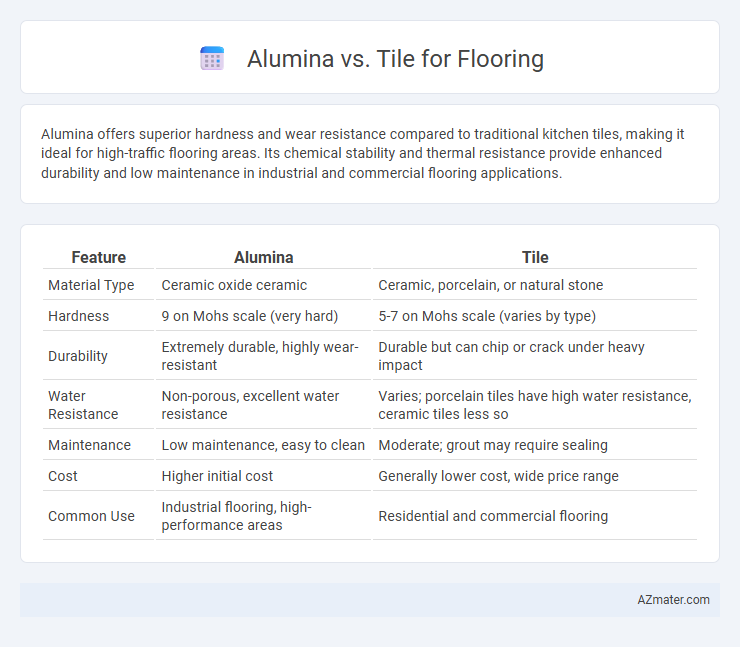Alumina offers superior hardness and wear resistance compared to traditional kitchen tiles, making it ideal for high-traffic flooring areas. Its chemical stability and thermal resistance provide enhanced durability and low maintenance in industrial and commercial flooring applications.
Table of Comparison
| Feature | Alumina | Tile |
|---|---|---|
| Material Type | Ceramic oxide ceramic | Ceramic, porcelain, or natural stone |
| Hardness | 9 on Mohs scale (very hard) | 5-7 on Mohs scale (varies by type) |
| Durability | Extremely durable, highly wear-resistant | Durable but can chip or crack under heavy impact |
| Water Resistance | Non-porous, excellent water resistance | Varies; porcelain tiles have high water resistance, ceramic tiles less so |
| Maintenance | Low maintenance, easy to clean | Moderate; grout may require sealing |
| Cost | Higher initial cost | Generally lower cost, wide price range |
| Common Use | Industrial flooring, high-performance areas | Residential and commercial flooring |
Introduction to Alumina and Tile Flooring
Alumina flooring consists of aluminum oxide-based materials known for exceptional hardness, durability, and resistance to wear, making it ideal for industrial and high-traffic areas. Tile flooring, commonly made from ceramic, porcelain, or natural stone, offers versatile design options, easy maintenance, and moisture resistance suitable for residential and commercial spaces. Understanding the composition and performance characteristics of alumina and tile flooring helps in selecting the best material based on durability, aesthetics, and environmental conditions.
Composition and Material Properties
Alumina flooring, composed of aluminum oxide, offers exceptional hardness, wear resistance, and thermal stability, making it suitable for industrial and high-traffic areas. Ceramic tiles, typically made from clay and other natural minerals, provide versatility and aesthetic appeal but have lower hardness and abrasion resistance compared to alumina. The dense, crystalline structure of alumina results in superior durability and chemical resistance, whereas tile materials vary widely in porosity and strength depending on their composition.
Durability and Longevity Comparison
Alumina flooring offers exceptional durability due to its high resistance to wear, corrosion, and impact, making it ideal for industrial and high-traffic areas. Tile flooring, particularly porcelain or ceramic, provides strong longevity with resistance to scratches and stains but can be prone to chipping or cracking under heavy impact. Overall, alumina's superior hardness and chemical stability ensure a longer lifespan and reduced maintenance compared to most tile options.
Moisture and Stain Resistance
Alumina flooring offers superior moisture resistance due to its non-porous surface, preventing water absorption and reducing the risk of mold and mildew compared to traditional tiles. Tile flooring, especially ceramic or porcelain, can vary in moisture resistance depending on the glaze and grout quality, with grout lines often being susceptible to staining and moisture penetration. Alumina's high stain resistance makes it ideal for areas prone to spills and contaminants, whereas tile surfaces may require regular sealing to maintain similar resistance levels.
Installation Process and Complexity
Alumina flooring installation requires specialized equipment and expertise due to its hardness and need for precise cutting, often involving diamond blades and professional grading for a smooth level surface. Tile flooring installation is generally more straightforward, involving surface preparation, layout planning, adhesive application, and grouting, which can be executed by experienced DIYers or professionals. The complexity of alumina lies in its durability and precision demands, while tile offers more flexibility but requires careful alignment and sealing for longevity.
Aesthetic Versatility and Design Options
Alumina flooring offers a sleek, modern aesthetic with a variety of finishes, including matte and glossy, making it ideal for contemporary spaces. Tile flooring provides an extensive range of design options, including diverse patterns, colors, textures, and materials like ceramic, porcelain, and natural stone, allowing for customization to suit traditional or eclectic interiors. Both materials accommodate creative design preferences, but tile's vast variety and print capabilities often deliver superior versatility for unique and intricate flooring designs.
Maintenance and Cleaning Requirements
Alumina flooring offers superior durability with low porosity, making it resistant to stains and easy to clean using mild detergents and water. Tile flooring, especially ceramic or porcelain, requires regular grout maintenance and sealing to prevent dirt buildup and mold growth, increasing cleaning efforts. Both materials benefit from routine sweeping and mopping, but alumina's non-porous surface minimizes the frequency of deep cleaning compared to tile.
Cost and Value Analysis
Alumina flooring offers superior durability and resistance to wear, making it a long-lasting investment compared to traditional tile options. Although the upfront cost of alumina flooring is higher, its low maintenance requirements and enhanced lifespan deliver greater value over time. Tile flooring presents a more affordable initial purchase but may incur additional costs due to frequent repairs and replacement, reducing overall cost-effectiveness.
Environmental Impact and Sustainability
Alumina flooring offers a highly sustainable option due to its durability and recyclability, reducing the need for frequent replacements and minimizing waste. Tile flooring, particularly ceramic or porcelain, often involves energy-intensive manufacturing processes and raw material extraction, impacting its environmental footprint. Choosing alumina can significantly lower carbon emissions over the product lifecycle, making it a more eco-friendly flooring solution.
Choosing the Right Flooring: Alumina or Tile
Choosing between alumina and tile for flooring depends on factors like durability, maintenance, and aesthetic preferences. Alumina, known for its exceptional hardness and resistance to wear, offers superior longevity in high-traffic areas, while ceramic or porcelain tiles provide versatile design options and ease of repair. Evaluating the specific application environment and budget constraints ensures the selection aligns with both functional requirements and style goals.

Infographic: Alumina vs Tile for Flooring
 azmater.com
azmater.com